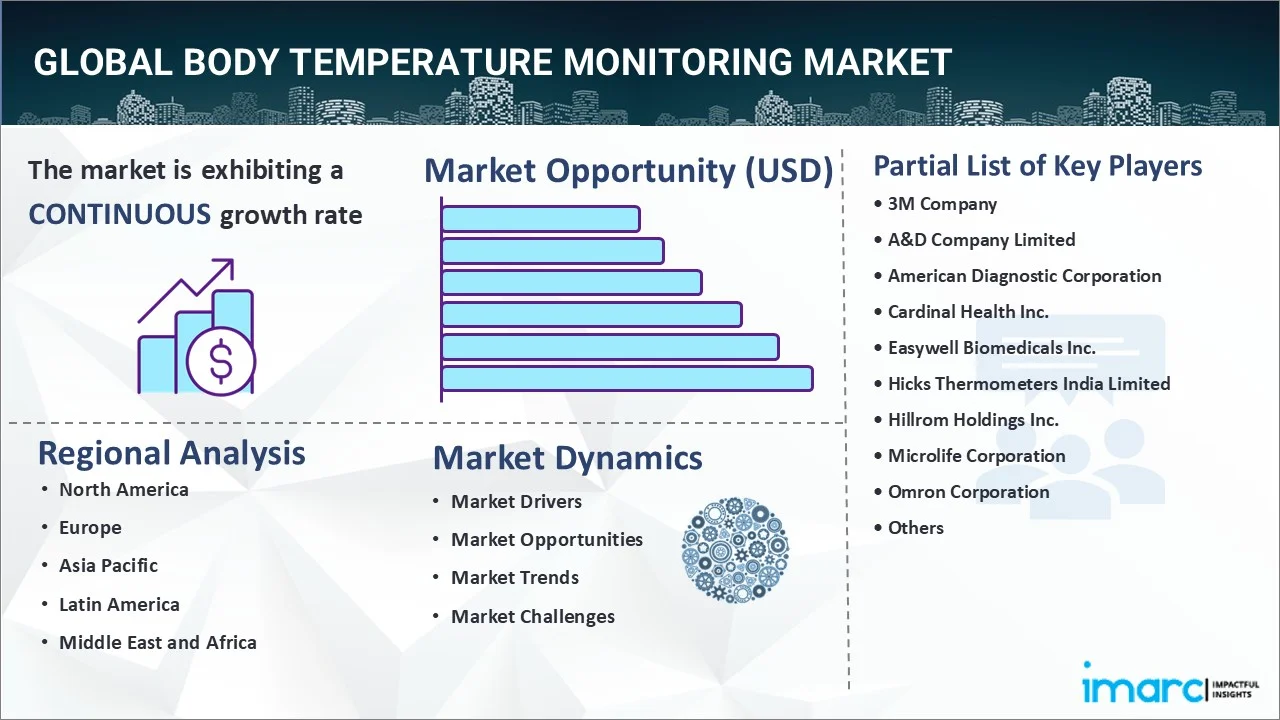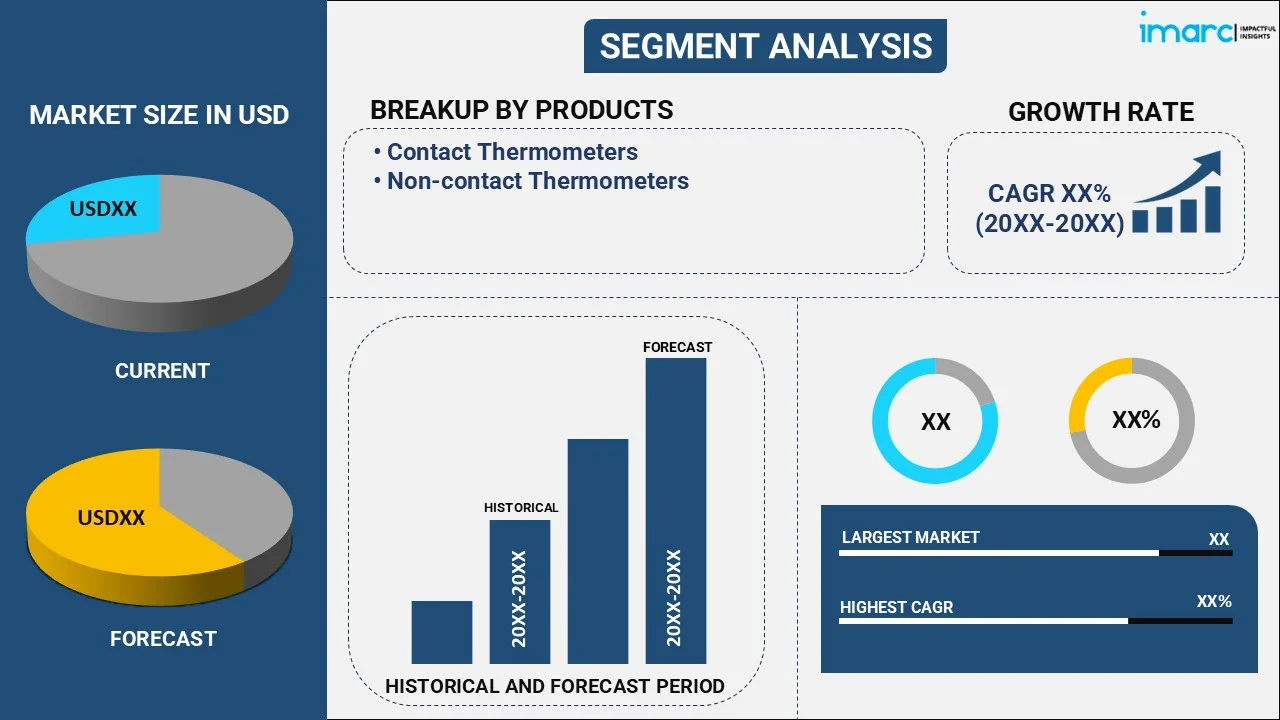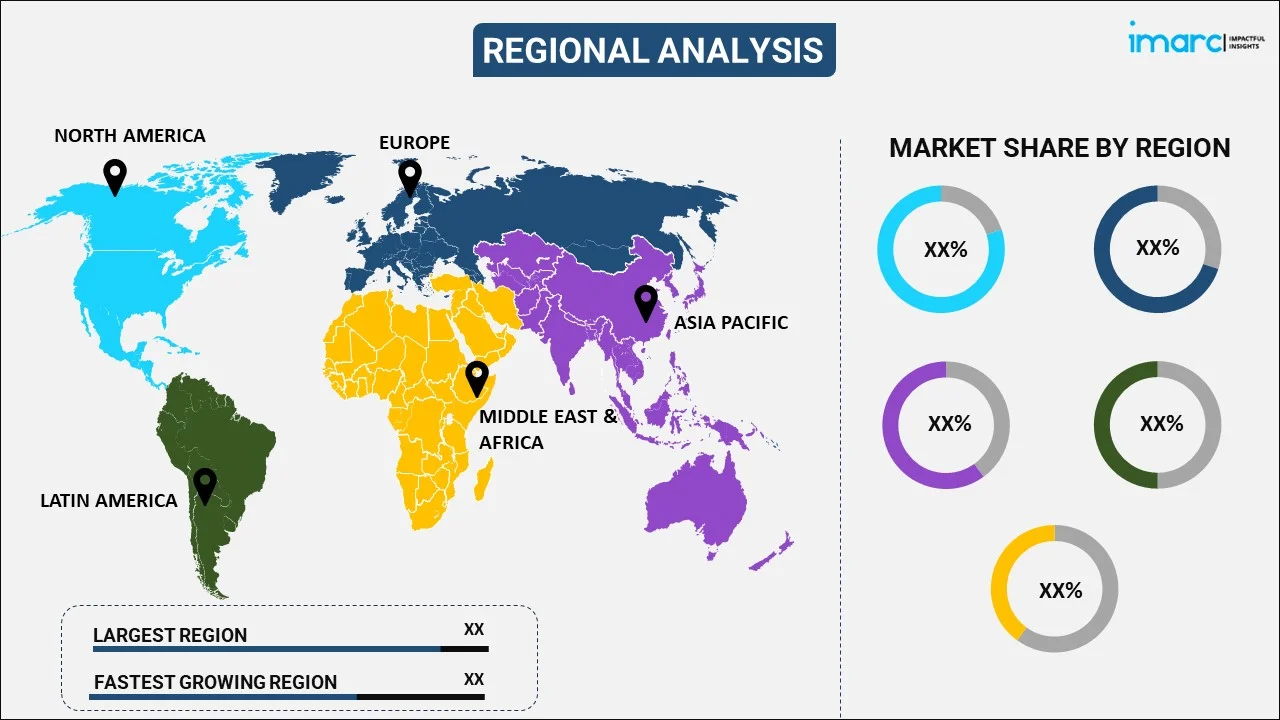
Body Temperature Monitoring Market Report by Product (Contact Thermometers, Non-contact Thermometers), Type (Rectum, Oral Cavity, Ear, Arm Pits, and Others), End Users (Hospitals and Clinics, Home Users, and Others), and Region 2025-2033
Body Temperature Monitoring Market Overview:
The global body temperature monitoring market size reached USD 2.0 Billion in 2024. Looking forward, IMARC Group expects the market to reach USD 3.5 Billion by 2033, exhibiting a growth rate (CAGR) of 6.14% during 2025-2033. The increasing prevalence of viral infections, rising number of airborne diseases, and the growing demand for RPM represent some of the key factors driving the market.
| Report Attribute | Key Statistics |
|---|---|
|
Base Year
|
2024 |
|
Forecast Years
|
2025-2033 |
|
Historical Years
|
2019-2024
|
|
Market Size in 2024
|
USD 2.0 Billion |
|
Market Forecast in 2033
|
USD 3.5 Billion |
| Market Growth Rate (2025-2033) |
6.14%
|
Body temperature monitoring refers to the process of measuring and tracking the temperature of the human body for identifying changes in temperature, which can be a sign of an underlying health issue. It can be measured by placing a thermometer in the mouth, under the armpit, in the ear, or rectally. It can also be determined through wearable devices, including smartwatches and fitness trackers, that rely on sensors to detect changes in the temperature of the body. It allows healthcare professionals to assess acute illness, inflammation, infection, and antigenic responses. It also aids in indicating the disease and analyzing the effectiveness of the treatment.

Body Temperature Monitoring Market Trends:
The surging prevalence of chronic diseases and viral infections that can cause fever or other changes in the body represents one of the major factors driving the demand for body temperature monitoring to observe the progression of the illness and track the effectiveness of a treatment. Moreover, increasing airborne diseases that can cause changes in body temperature on account of the rising air pollution levels is catalyzing the demand for body temperature monitoring. This, coupled with the growing geriatric population, which is more susceptible to different medical conditions, such as influenza, pneumonia, malaria, rheumatoid arthritis, ulcerative colitis, and endocarditis, is influencing the market positively. In addition, the increasing demand for remote patient monitoring (RPM) and significant improvements in the healthcare sector is favoring the growth of the market. Apart from this, the rising adoption of body temperature monitoring devices in commercial complexes, such as shopping malls, schools, restaurants, theatres, and stores, for minimizing the risk of transmitting the infections is contributing to the market growth. Furthermore, there is an increase in the adoption of wearable devices that can be connected with smart devices for collecting patient data in real time. This, along with the growing utilization of mobile health (m-health) applications, is propelling the growth of the market. Besides this, the growing adoption of body temperature monitoring devices among individuals who participate in professional sports and other physical activities to gain knowledge and detailed insights about body heat and improve performance is creating a positive outlook for the market.
Key Market Segmentation:
IMARC Group provides an analysis of the key trends in each sub-segment of the global body temperature monitoring market report, along with forecasts at the global, regional and country level from 2025-2033. Our report has categorized the market based on product, type and end users.
Product Insights:

- Contact Thermometers
- Disposable Thermometers
- Infrared Ear Thermometers
- Digital thermometers
- Mercury Thermometers
- IR Temporal Artery Thermometers
- Others
- Non-contact Thermometers
The report has provided a detailed breakup and analysis of the body temperature monitoring market based on the product. This includes contact thermometers (disposable thermometers, infrared ear thermometers, digital thermometers, mercury thermometers, IR temporal artery thermometers, and others) and non-contact thermometers. According to the report, contact thermometers (disposable thermometers, infrared ear thermometers, digital thermometers, mercury thermometers, IR temporal artery thermometers, and others) represented the largest segment.
Type Insights:
- Rectum
- Oral Cavity
- Ear
- Arm Pits
- Others
A detailed breakup and analysis of the body temperature monitoring market based on the type has also been provided in the report. This includes rectum, oral cavity, ear, arm pits, and others. According to the report, oral cavity accounted for the largest market share.
End Users Insights:
- Hospitals and Clinics
- Home Users
- Others
The report has provided a detailed breakup and analysis of the body temperature monitoring market based on the product. This includes hospitals and clinics, home users, and others. According to the report, hospitals and clinics represented the largest segment.
Regional Insights:

- North America
- United States
- Canada
- Asia-Pacific
- China
- Japan
- India
- South Korea
- Australia
- Indonesia
- Others
- Europe
- Germany
- France
- United Kingdom
- Italy
- Spain
- Russia
- Others
- Latin America
- Brazil
- Mexico
- Others
- Middle East and Africa
The report has also provided a comprehensive analysis of all the major regional markets, which include North America (the United States and Canada); Asia Pacific (China, Japan, India, South Korea, Australia, Indonesia, and others); Europe (Germany, France, the United Kingdom, Italy, Spain, Russia, and others); Latin America (Brazil, Mexico, and others); and the Middle East and Africa. According to the report, North America (the United States and Canada) was the largest market for body temperature monitoring. Some of the factors driving the North America body temperature monitoring market included the easy availability, product innovations, marketing strategies, etc.
Competitive Landscape:
The report has also provided a comprehensive analysis of the competitive landscape in the global body temperature monitoring market. Competitive analysis such as market structure, market share by key players, player positioning, top winning strategies, competitive dashboard, and company evaluation quadrant has been covered in the report. Also, detailed profiles of all major companies have been provided. Some of the companies covered include 3M Company, A&D Company Limited, American Diagnostic Corporation, Cardinal Health Inc., Easywell Biomedicals Inc., Hicks Thermometers India Limited, Hillrom Holdings Inc., Microlife Corporation, Omron Corporation, Terumo Corporation, etc. Kindly note that this only represents a partial list of companies, and the complete list has been provided in the report.
Report Coverage:
| Report Features | Details |
|---|---|
| Base Year of the Analysis | 2024 |
| Historical Period | 2019-2024 |
| Forecast Period | 2025-2033 |
| Units | Billion USD |
| Segment Coverage | Product, Type, End Users, Region |
| Region Covered | Asia Pacific, Europe, North America, Latin America, Middle East and Africa |
| Countries Covered | United States, Canada, Germany, France, United Kingdom, Italy, Spain, Russia, China, Japan, India, South Korea, Australia, Indonesia, Brazil, Mexico |
| Companies Covered | 3M Company, A&D Company Limited, American Diagnostic Corporation, Cardinal Health Inc., Easywell Biomedicals Inc., Hicks Thermometers India Limited, Hillrom Holdings Inc., Microlife Corporation, Omron Corporation and Terumo Corporation |
| Customization Scope | 10% Free Customization |
| Post-Sale Analyst Support | 10-12 Weeks |
| Delivery Format | PDF and Excel through Email (We can also provide the editable version of the report in PPT/Word format on special request) |
Key Benefits for Stakeholders:
- IMARC’s report offers a comprehensive quantitative analysis of various market segments, historical and current market trends, market forecasts, and dynamics of the body temperature monitoring market from 2019-2033.
- The research study provides the latest information on the market drivers, challenges, and opportunities in the global body temperature monitoring market.
- The study maps the leading, as well as the fastest-growing, regional markets. It further enables stakeholders to identify the key country-level markets within each region.
- Porter's five forces analysis assist stakeholders in assessing the impact of new entrants, competitive rivalry, supplier power, buyer power, and the threat of substitution. It helps stakeholders to analyze the level of competition within the body temperature monitoring industry and its attractiveness.
- Competitive landscape allows stakeholders to understand their competitive environment and provides an insight into the current positions of key players in the market.
Key Questions Answered in This Report
The global body temperature monitoring market was valued at USD 2.0 Billion in 2024.
We expect the global body temperature monitoring market to exhibit a CAGR of 6.14% during 2025-2033.
The rising utilization of body temperature monitoring devices, as they assist in characterizing the disease and analyzing the effectiveness of the treatment, is primarily driving the global body temperature monitoring market.
The sudden outbreak of the COVID-19 pandemic has led to the growing demand for temperature monitoring devices among individuals, as they aid in providing early warning signs of fever and infection caused by the coronavirus disease.
Based on the product, the global body temperature monitoring market can be segmented into contact thermometers and non-contact thermometers. Currently, contact thermometers hold the majority of the total market share.
Based on the type, the global body temperature monitoring market has been divided into rectum, oral cavity, ear, arm pits, and others. Among these, oral cavity currently exhibits a clear dominance in the market.
Based on the end users, the global body temperature monitoring market can be categorized into hospitals and clinics, home users, and others. Currently, hospitals and clinics account for the largest market share.
On a regional level, the market has been classified into North America, Asia-Pacific, Europe, Latin America, and Middle East and Africa, where North America currently dominates the global market.
Some of the major players in the global body temperature monitoring market include 3M Company, A&D Company Limited, American Diagnostic Corporation, Cardinal Health Inc., Easywell Biomedicals Inc., Hicks Thermometers India Limited, Hillrom Holdings Inc., Microlife Corporation, Omron Corporation, and Terumo Corporation.
Need more help?
- Speak to our experienced analysts for insights on the current market scenarios.
- Include additional segments and countries to customize the report as per your requirement.
- Gain an unparalleled competitive advantage in your domain by understanding how to utilize the report and positively impacting your operations and revenue.
- For further assistance, please connect with our analysts.
 Inquire Before Buying
Inquire Before Buying
 Speak to an Analyst
Speak to an Analyst
 Request Brochure
Request Brochure
 Request Customization
Request Customization




.webp)




.webp)












